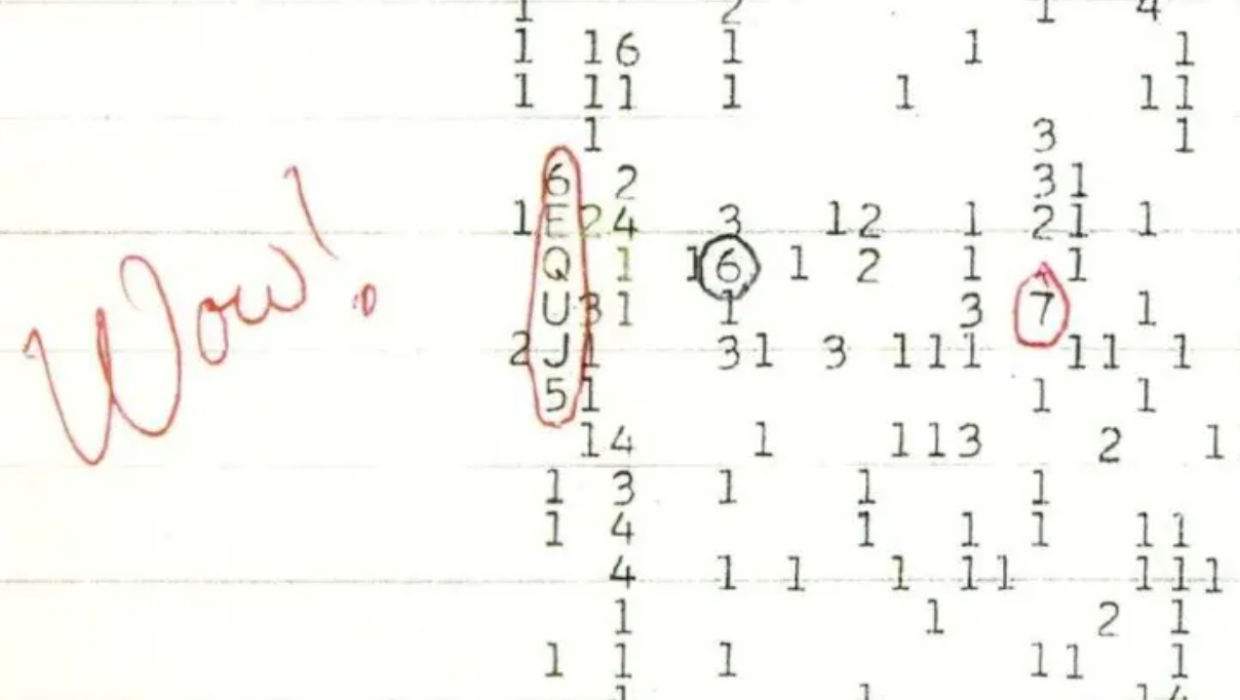Science
Scientists Pinpoint Natural Source of 1977 Alien Radio Signal

A long-standing mystery surrounding a radio signal detected in 1977 may finally have been unraveled by scientists. The signal, famously known as the “Wow! signal,” is now believed to have a natural origin, rather than being a communication from extraterrestrial life.
The signal was captured by the Big Ear radio telescope at Ohio State University on August 15, 1977. It lasted for 72 seconds and was so unusual that astronomer Jerry R. Ehman famously circled it on a printout and wrote “Wow!” next to it. For decades, the origin of this signal has been a topic of intrigue, with many speculating it might be evidence of alien life.
Recent investigations led by Dr. Antonio Paris, an astronomer at the Planetary Science Institute, have provided new insights into this enigma. Dr. Paris and his team analyzed historical data alongside contemporary observations. They concluded that the signal likely originates from a natural astronomical phenomenon, specifically the emissions from a comet.
In their research, Dr. Paris’s team focused on the timing of the Wow! signal in relation to the positions of nearby comets. They identified that the signal’s frequency aligns with the expected emissions from a specific type of comet, designated 2P/Encke, which was near Earth at the time of the detection. This finding suggests that the radio waves detected were not an alien transmission but rather natural emissions from the comet’s interaction with solar winds.
The implications of this discovery are significant for the field of astrophysics and the ongoing search for extraterrestrial intelligence. Understanding the origins of such signals helps researchers differentiate between natural astronomical phenomena and potential communications from intelligent life forms.
The Wow! signal had long been a cornerstone in the search for extraterrestrial signals, often cited in discussions about the existence of alien life. The shift in understanding highlights the importance of continuous research and the need for skepticism regarding extraordinary claims without substantial evidence.
While the conclusion drawn by Dr. Paris and his team provides clarity on the Wow! signal, the quest for signs of life beyond Earth continues. As technology advances, researchers are better equipped to explore the cosmos, looking for both natural phenomena and potential signals from intelligent beings.
This research not only sheds light on one of the most famous signals in the history of astronomy but also reinforces the complexity of space exploration. The ongoing work by scientists globally aims to uncover the mysteries of the universe and our place within it.
-

 World4 months ago
World4 months agoTest Your Knowledge: Take the Herald’s Afternoon Quiz Today
-

 Sports4 months ago
Sports4 months agoPM Faces Backlash from Fans During Netball Trophy Ceremony
-

 Lifestyle4 months ago
Lifestyle4 months agoDunedin Designers Win Top Award at Hokonui Fashion Event
-

 Entertainment4 months ago
Entertainment4 months agoExperience the Excitement of ‘Chief of War’ in Oʻahu
-

 Sports4 months ago
Sports4 months agoLiam Lawson Launches New Era for Racing Bulls with Strong Start
-

 World5 months ago
World5 months agoCoalition Forms to Preserve Māori Wards in Hawke’s Bay
-

 Health4 months ago
Health4 months agoWalking Faster Offers Major Health Benefits for Older Adults
-

 Lifestyle4 months ago
Lifestyle4 months agoDisney Fan Reveals Dress Code Tips for Park Visitors
-

 Politics4 months ago
Politics4 months agoScots Rally with Humor and Music to Protest Trump’s Visit
-

 Top Stories5 months ago
Top Stories5 months agoUK and India Finalize Trade Deal to Boost Economic Ties
-

 Health2 months ago
Health2 months agoRadio Host Jay-Jay Feeney’s Partner Secures Visa to Stay in NZ
-

 World5 months ago
World5 months agoHuntly Begins Water Pipe Flushing to Resolve Brown Water Issue









